Fluid composition receiving layer for printed conductive layers and methods therefor
- Summary
- Abstract
- Description
- Claims
- Application Information
AI Technical Summary
Benefits of technology
Problems solved by technology
Method used
Image
Examples
example 4
[0062]Using thermal inkjet technology in conjunction with aqueous-based fluids, a functional two-metal layer circuit was constructed on an epoxy F-4 board (0.8 m thick). The circuit successfully functioned when powered by a 9 volt battery applied to cathode and anode terminals thereof, causing light emitting diode components of the circuit to flash in an alternating pattern.
[0063]Returning to FIG. 2, and with additional reference to FIGS. 7, 8A and 8B, the circuit was fabricated on a substrate 12, and included a first conductive layer 16a and a second conductive layer 16b, applied on a first FCRL 14a and a second FCRL 14b, respectively. Dielectric layer 18 was provided to isolate the conductive layers 16a and 16b from one another. The various layers were applied using a micro-fluid jet printer and aligned using alignment marks AM. The connection between the conductive layers 16a and 16b is made through a via V and a step down feature SD, having an opening in the dielectric layer OD ...
PUM
| Property | Measurement | Unit |
|---|---|---|
| temperatures | aaaaa | aaaaa |
| temperatures | aaaaa | aaaaa |
| viscosity | aaaaa | aaaaa |
Abstract
Description
Claims
Application Information
 Login to View More
Login to View More - R&D
- Intellectual Property
- Life Sciences
- Materials
- Tech Scout
- Unparalleled Data Quality
- Higher Quality Content
- 60% Fewer Hallucinations
Browse by: Latest US Patents, China's latest patents, Technical Efficacy Thesaurus, Application Domain, Technology Topic, Popular Technical Reports.
© 2025 PatSnap. All rights reserved.Legal|Privacy policy|Modern Slavery Act Transparency Statement|Sitemap|About US| Contact US: help@patsnap.com



